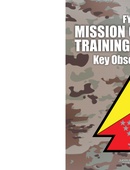
The Center for Army Lessons Learned leads the Army Lessons Learned Program and delivers timely and relevant information to resolve gaps, enhance readiness, and inform modernization.

Downloads: 233
Hits: 233
Key observations from the Mission Command Training Program (MCTP) for FY 24 Warfighter Exercises (WFX). Trends and observations identified by trainers and... read more
Key observations from the Mission Command Training Program (MCTP) for FY 24 Warfighter Exercises (WFX). Trends and observations identified by trainers and leaders from MCTP from corps and division headquarters during command post exercises (CPX) in a large-scale combat operations environment. The observations are organized by warfighting and enabling functions, and cover Europe and Pacific based scenarios. These observations identify key areas that cause challenges corps and divisions, and provide input, guidance, and references to help overcome these challenges for future rotational units. The observations are based upon after action review (AAR) and exercise report content and represent multiple units. Commanders and staff should review these observations and incorporate elements into standard operating procedures, training plans, and preparation for future CPX and operations.
less

Downloads: 174
Hits: 174
The U.S. Army is integrating two AI-powered tools, CamoGPT and NIPRGPT, to improve operational efficiency. These tools, built on Large Language Models... read more
The U.S. Army is integrating two AI-powered tools, CamoGPT and NIPRGPT, to improve operational efficiency. These tools, built on Large Language Models (LLMs), can assist with tasks like intelligence processing, administrative work, summarizing information, and data extraction.
less

Downloads: 141
Hits: 141
This article examines why divisions fall into the trap of neglecting FUOPS and Plans integration, and how they can overcome this challenge.

Downloads: 124
Hits: 124
The 36th Engineer Brigade participated in the North Atlantic Treaty Organization (NATO) joint exercise "Defender Europe 2024". This product identifies... read more
The 36th Engineer Brigade participated in the North Atlantic Treaty Organization (NATO) joint exercise "Defender Europe 2024". This product identifies lessons learned by the engineer brigade from conducting maneuver support with NATO partners in the Eastern European area of operations.
less

Downloads: 142
Hits: 142
The Russia-Ukraine conflict has reached a stalemate over the past two years. Tactical-level combat power losses in both the Russian Ground Forces (RGF) and... read more
The Russia-Ukraine conflict has reached a stalemate over the past two years. Tactical-level combat power losses in both the Russian Ground Forces (RGF) and Ukrainian Armed Forces (UAF) have reduced the operational-level endurance necessary to bring the conflict to an end. In any future large-scale combat operation against a pacing or acute threat, U.S. Army units must be prepared to conduct operations in a contested logistical environment. To train as it will fight, the U.S. Army must emphasize conserving sufficient combat power during collective training of tactical combat tasks. This paper will present endurance-related observations from the Russia-Ukraine conflict and U.S. Army collective training events, discuss potential impacts on the U.S. Army, and offer recommendations to mitigate identified challenges.
less

Downloads: 141
Hits: 141
This paper describes both best practices and recommendations for M-SHORAD batteries in support of the Brigade Combat Team (BCT and division), specifically... read more
This paper describes both best practices and recommendations for M-SHORAD batteries in support of the Brigade Combat Team (BCT and division), specifically regarding the role of the Air Defense Coordinator, employment of Stinger and Counter-Small Unmanned Aircraft Systems, and engagement authority within the division. The ADA branch must continually examine the role of SHORAD and mission command dynamics to set conditions for success in future SHORAD implementation. This paper references the yet-to-be-published DM 3-01 to provide appropriate context for NTC rotation 25-02. Charlie Battery, 6th Battalion, 56th Air Defense was the supporting M-SHORAD Battery during this rotation.
less







